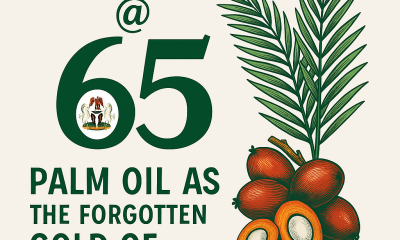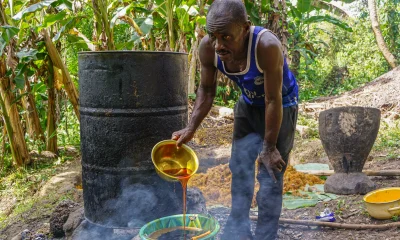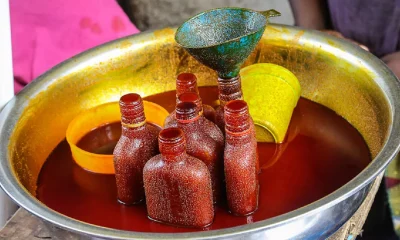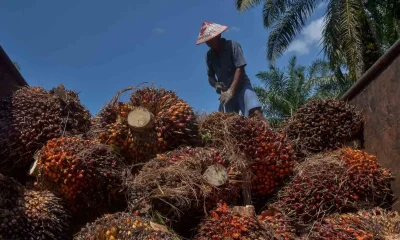Global Trend
Global Palm Oil Market 2025: Forecasts Every African Trader Must Read

Palm oil has long been a linchpin of global vegetable oils, especially in food, cosmetics, and increasingly biofuels. For African traders, understanding 2025’s market dynamics isn’t optional—it’s essential. With shifting policies, rising demand in key importing countries, and tightening supply, the forecasts for 2025 hold both opportunity and risks. Here’s what is changing, what’s likely to happen, and what African exporters and traders must prepare for.
1. Big Picture: Demand Pull & Policy Push
India & China Regain Strength:- Two of the biggest stories in the palm oil market in 2025 are India and China stepping up demand, often because palm oil is becoming more price-competitive relative to other oils.
- According to a Reuters poll and analysis by the Malaysian Palm Oil Council (MPOC), as of April 2025, palm oil had become reasonably priced (around 3,900 ringgit / ~$889/ton) compared with soybean oil. That narrowing of the price gap has pushed import demand in both India and China. Reuters
- India, for example, posted palm oil imports of 990,528 metric tons in August 2025 — a one-year high — as festive demand and favorable pricing drove purchases. Reuters
These markets are hungry: India’s edible oil demands keep growing, and China, though more sensitive to price and quality, is also increasing its inventories and import volumes. For African exporters, that means potential new buyers or more competitive positioning for export volumes — if quality, traceability, and supply reliability are in check.
Policy Drivers in Producer Countries:- On the supply side, some of the key policy changes are pushing upward pressures on price, or making exports more constrained.
- Indonesia is increasing its biodiesel mandates (B40, meaning 40% biodiesel blend) which reduces the volume of crude palm oil (CPO) available for export. That demand pull for domestic use tends to tighten supply in global markets. Reuters+2S&P Global+2
- Also, Indonesia raised its export levy on crude palm oil from 7.5% to 10% in May 2025. That policy shift is aimed to support domestic priorities (like smallholders, replanting etc.) but has the effect of raising costs for importing countries, including many in Africa. Tridge+1
These supply side constraints tend to support higher prices globally, especially when demand remains strong or grows.
2. Short-Term Forecasts: What to Expect in 2025
Putting demand and supply forces together, here are some near-term trends likely to stand out in 2025:
- Prices Average Higher: A Reuters poll expects benchmark Malaysian crude palm oil (CPO) futures to average about RM 4,350/tonne in 2025 (~US$970-$1,000, depending on exchange rates), up about 5.4% over 2024. Reuters
- Tightening Global Supply: While Malaysia’s output is expected to rise modestly, Indonesia’s biodiesel mandates and export levies will tighten the pool of oil available for export. There are also warnings about adverse weather and labour shortages in Malaysia. Nairametrics+3prestasisawit.mpob.gov.my+3Tridge+3
- Rising Import Costs for Africa: With policies like Indonesia’s export levy hike and stronger demand in Asia, the cost base for imports to Africa will rise. That means more pressure on African demand, especially in countries heavily dependent on imported palm oil. Tridge+1
3. Medium-Long Term Trends: Toward 2027 and Beyond
These shorter-term dynamics feed into medium-term trends. Traders should be especially mindful of:
- Growing Refined Palm Oil Demand in Africa: According to IndexBox, Africa’s refined palm oil market is expected to grow to ~19 million tons and a market value of US$23.3 billion by 2035. That means demand for processed oils (not just crude) is rising rapidly. IndexBox
- Consumption Volume Growth vs Value Growth: Volume growth in Africa is forecast to be modest (+0.8% CAGR 2024-2035), but value growth may be more substantial (+2.7% or more) thanks to rising refined product demand, value addition, and possibly margin inflation due to supply constraints. IndexBox+1
- Export Growth from African Producers: Africa is seeing gains in export volumes. In 2024 exports jumped to 1.1 million tons (≈48% increase over 2023). Key exporting countries include Djibouti, Côte d’Ivoire, Kenya, Gabon, Liberia and Uganda. This demonstrates that Africa, while still net importer overall, is becoming more competitive in certain niches. IndexBox
4. Real-Life Examples: What African Players Are Already Doing
To move from forecasts to concrete lessons, here are examples of how African producers/traders are responding to the shifting global market.
Côte d’Ivoire – PalmCI’s Strong Q1, 2025 Performance:- PalmCI, one of the leading producers in Côte d’Ivoire, saw revenue jump 32% year-on-year in Q1 2025, reaching 67.52 billion CFA francs (≈ US$117.3 million). Net profit rose by 65% to ~11.56 billion CFA francs (≈ US$20.1 million). The boost came from higher crude palm oil prices (≈ +20%) and a 7% increase in sales volumes. allAfrica.com
This tells two important things:
- First, when global prices rise, those who are relatively well-positioned (decent production capacity, good supply logistics) benefit quickly.
- Second, even modest CAGR in volume (7%) can combine with price upticks to generate large profit jumps.
Nigeria – Import Dependence & Price Sensitivity:- Nigeria is the largest palm oil producer in Africa (≈ 1.4 million tonnes per year) but is still heavily reliant on imports to satisfy domestic demand. When Indonesia increased its export levy, Nigerian importers faced higher costs, which translate into rising local prices. Nairametrics+2prestasisawit.mpob.gov.my+2
A specific example: The CPO export tax increase in Indonesia is expected to push up prices Nigeria imports, since many Nigerian processors source from Malaysia/Indonesia. This adds to cooking-oil inflation locally. Traders in Nigeria must factor in such external policy shifts when planning supply, contracts, and pricing.
Ghana – New Investment Partnerships:- Ghana’s oil palm industry has been revitalized by recent investment deals such as the Oro Oil Ghana-Nigerian partnership. The deal involves Nigerian investment into Ghanaian plantations and machinery to improve production, expand markets, and reduce reliance on traditional, lower-yield cultivation methods. Graphic
This shows forward-looking strategy: combining capital, expertise, and cross-border collaboration to capture benefits from rising global demand and mitigate the risks of import price shocks.
5. Risks & Headwinds to Watch
Even with optimistic trends, several threats could disrupt forecasts. African traders must keep these in mind.
- Regulatory Pushbacks & Sustainability Rules: The EU’s Deforestation Regulation (EUDR) and similar policies will require suppliers to meet stricter traceability and documentation. Non-compliance can block or reduce exports. Financial Times+1
- Export Levies & Domestic Policies in Producer Countries: As seen in Indonesia, higher levies or stronger domestic mandates (e.g. biodiesel blending) reduce exportable volumes. These are outside many African exporters’ control but affect global pricing and supply. S&P Global+2Reuters+2
- Weather, Labor, & Plantation Age: Output from Southeast Asia is vulnerable to climate variations, ageing palms, labour shortages, and diseases. If production falters there, global supply tightens, raising volatility. Reuters+1
- Competition from Substitute Oils: Soybean, sunflower, canola oils are always in play. If prices for those drop or yield increases elsewhere occur, demand for palm oil may be partially supplanted. Also, as consumers get more health-conscious, oils with better profiles (less saturated fat, organic, etc.) may regain market share.
6. What African Traders Must Do to Win in 2025
To leverage forecasted global trends profitably, African exporters and traders need smart strategy. Here are action items:
- A. Build/Strengthen Traceability and Certification:- Works like tracing palm oil from farm to export, verifying quality, ensuring no illegal deforestation or harmful practices. With importers more careful, being able to prove sustainability credentials is increasingly non-negotiable.
- B. Monitor Policies Abroad Constantly:- A change in Indonesia or Malaysia’s export levies, or India’s import duty (including duty cuts), can change the competitive landscape almost overnight. Traders must stay plugged into news, possibly through local industry bodies, trade associations, or subscriptions to market intelligence.
- C. Secure Reliable Supply Chains:- Don’t rely solely on imports or distant suppliers with uncertain cost or policy exposure. Strengthening local plantations, investing in better yields, and optimizing logistics can reduce vulnerabilities. Example: Ghana partnering with outside investors for plantation improvement.
- D. Focus on Value Addition:- Since global demand is rising not just for crude palm oil but for refined, processed, value-added oils (RBD olein etc.), African traders who can refine locally and package or process downstream will get better margins. Also, the forecasts for Africa’s refined palm oil market growing to ~19 million tons by 2035 show that value-added products matter. IndexBox
- E. Hedge for Price and Exchange Rate Volatility:- Because global palm oil pricing is affected by supply disturbances, tax/levy shifts, climate/weather, new laws, etc., exporters should use forward contracts, lock in supply volume, maybe explore derivative contracts if possible. Also, since many costs (shipping, inputs) are imported or tied to global markets or foreign currencies, movements in FX can eat margins.
- F. Target Emerging & Premium Markets:- Beyond commoditized bulk markets, there’s growth in specialty oils, oleochemicals, industrial uses, and markets with demand for “green” and certified oil. For example, Malaysia is targeting industrial applications and specialty fats in its strategy for Sub-Saharan Africa and MENA. The Edge Malaysia
7. Forecast Snapshot: What Prices, Volumes & Profits Might Look Like
While we avoid tables here, some estimates and likely ranges are worth knowing:
- Malaysian CPO futures in 2025 are expected to average about RM 4,350/tonne (~US$970-US$1,000), up ~5-6% from 2024. Reuters
- African refined palm oil demand is projected to grow steadily, with exports from Africa up by ~50% year-on-year, though from a smaller base. Example: Africa exported ~1.1 million tons palm oil in 2024, up ~48% relative to 2023. IndexBox
- Cost pressures (shipping, export levies, biofuel mandates) will squeeze margins unless efficiency is improved. For import-dependent countries, retail price increases are likely. For producers, improving yield and minimizing losses will be critical to maintaining profitability.
8. What to Watch Closely (Trailing Indicators)
Here are metrics and signals that traders should monitor in near real time, because they tend to presage bigger shifts:
- Changes or announcements in biodiesel blending mandates (Indonesia, Malaysia, India).
- Export levies or tax structure changes in key producer countries.
- Price differential between palm oil and its main rivals (soybean, sunflower). When palm becomes significantly cheaper, demand surges. When rivals drop, substitution may rise.
- Weather/climate reports in major oil palm producing regions (Malaysia, Indonesia, parts of Africa).
- Regulatory or sustainability policy shifts in importing regions (EU, China, India), especially about deforestation, traceability, and health/safety.
- Import data from African countries; e.g. Kenya’s forecast to import 1.05 million tonnes in 2025/26, mostly from Malaysia, showing reliance and potential pricing vulnerability. Ecofin Agency
Conclusion: Strategies for African Traders in 2025
2025 is shaping up to be a year of both risk and opportunity for the global palm oil market. For African traders, the upside is real: rising global demand, tightening supply elsewhere, and growing refined product opportunities. But the flipside is that external shocks, regulatory changes, and rising input / supply chain costs can erode margins quickly.
To capitalize, African traders should:
- Secure good quality, certified supply
- Monitor global policy shifts and export levies
- Build or partner for local processing / refining
- Be agile with contracts and price hedging
- Invest in marketing, branding, and export compliance
Deal smartly with these, and 2025 can be a breakthrough year for expansion, profits, and global relevance. Miss them, and some players risk being sidelined as cheaper bulk supply from Asia or shifting global consumption patterns reduce space for those who lag.































